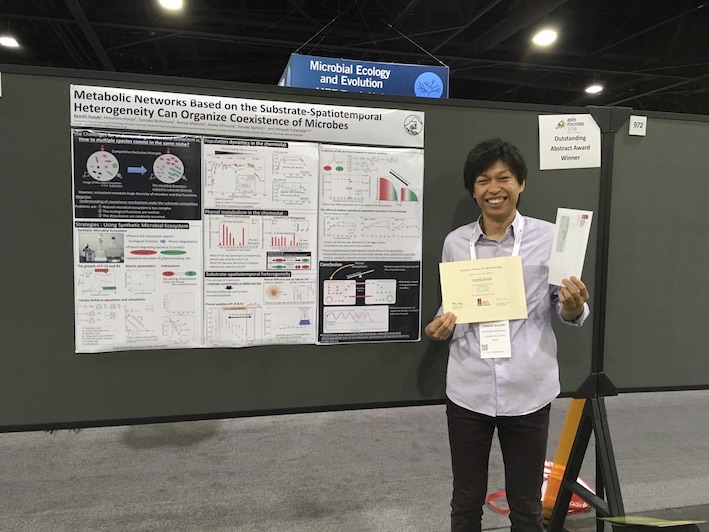静岡大学の鈴木研志 会員がASM microbe2018にてOutstanding Abstract awardを受賞!
学会員の皆様
このたび、静岡大学の鈴木 研志 学生会員(二又裕之研究室)がASM microbe2018にてOutstanding Abstract awardを受賞いたしました。以下に受賞者のコメントと、発表要旨等をお知らせいたします。このたびは誠におめでとうございました。
受賞者のコメント
このたび、American Society of Microbiology学会の年次大会ASM microbe2018にてOutstanding Abstract awardを受賞しました。また副賞として賞金200ドルを頂きました。日頃から熱心な指導をして頂いた指導教員の二又裕之教授と諸先生方にこの場を借りて御礼申し上げます。
学会ではPoster発表に加え、Poster Talkセッションでの発表にも選出され口頭での発表を行ってきました。本賞の受賞をタネに同セッションの発表者やオーガナイザーと議論を交わすことができ貴重な経験となりました。詳細は後日、微生物生態学会和文誌「国際学会見聞録」に掲載予定です。
今回の受賞を励みに研究に情熱を注ぐと同時に、人として成長していけるよう努力していきます。
会議名:ASM microbe2018
場所:Georgia world congress center, Atlanta
期日:2018年6月7-11日
Title
Metabolic Networks Based on the Substrate-Spatiotemporal Heterogeneity Can Organize Coexistence of Microbes
Abstract
Microbial communities are ubiquitously found in nature and maintain the huge diversity. It has been considered that microbial diversity contributes to maintain ecological functions. However, how to coexist multispecies and maintain the microbial diversity are unknown although the competitive exclusion principle demonstrated that only strain exhibiting the highest competitiveness occupies the niche. Cupriavidus sp. P-10 and Comamonas testosteroni R2 were co-cultured with phenol as the sole carbon and energy source in a chemostat to reveal the coexistence mechanism under the substrate-competing condition. Simulation depending on Lotoka-Volterra equations predicted that strain R2 became dominant and strain P-10 was washed out. However, these strains coexisted and strain P-10 became dominant in the chemostat culture. The kinetic parameters for phenol indicated that the phenol concentration exhibiting Vmav of strain P-10 was higher than that of strain R2. It was shown that phenol concentration was spatiotemporally heterogeneous in the chemostat, suggesting that strain P-10 obtained a chance to acquire phenol. Actually, a dominant strain changed from strain P-10 to strain R2 corresponding to the decrease of phenol loading rate. When strain P-10 was dominant, the transcription of the gene encoding phenol hydroxylase (LmPH) was observed in only strain P-10. Interestingly, total cells yield in the coexisting culture was higher than distinct pure culture. These results suggested that spatiotemporal heterogeneity allowed strain P-10 to overcome the competition with strain R2 and that strain R2 could survive using metabolites from strain P-10. Coexistence collapsed when strain R2 dominated, where only strain R2 expressed LmPH and strain P-10 washed out. These results suggested that coexistence was organized when metabolic networks were constructed between microorganisms, which would be one of maintenance mechanism of microbial diversity in the nature.










